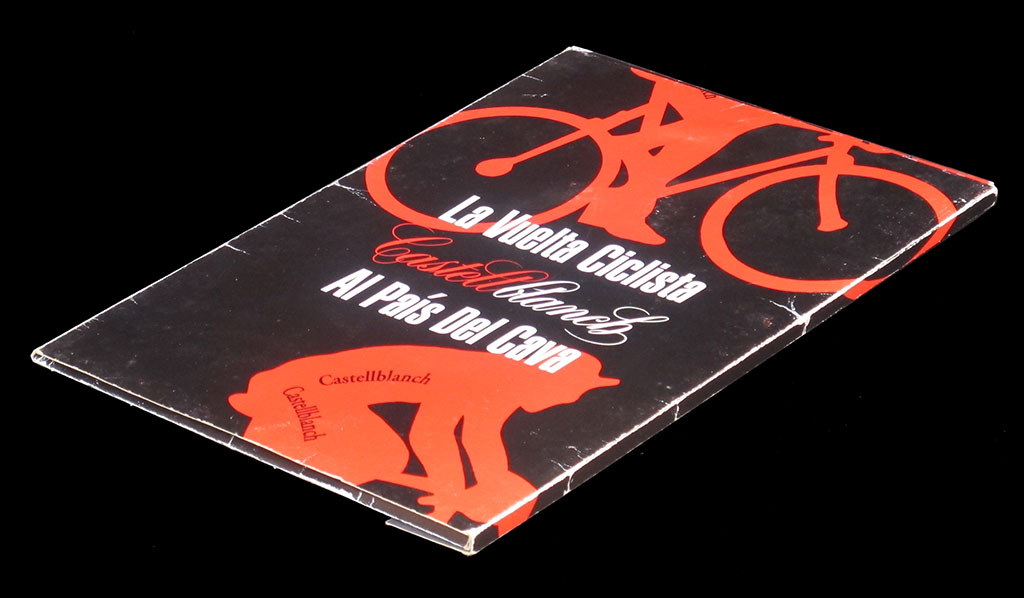
LA VUELTA CICLISTA
AL PAIS DEL CAVA
Castellblanch, Spain, 1990s

This is a rather unusual promotional game for a Catalan sparkling wine brand. Although it was produced quite near where I live, and probably in a quite large edition, I had never seen it before. I guess most copies did not survive long, or else are forgotten in the homes of those who received them.
Castellblanch is a well-known brand of cava, founded as a family business in 1908, subsequently absorbed as part of the controversial Rumasa holding in the 1970s, and which has been owned by the Freixenet group since 1984. One wonders why they would promote a Champagne-like beverage with a cycling game, but of course Amstel promotes a beer with a cycling race, so I have no objections.
UPDATE June 2025: Castellblanch not only promoted their products with a cycling game, but they even sponsored a professional cycling team during the seasons 1994 and 1995. Their best results were the three stage wins by the German sprinter Marcel Wüst in the 1995 Vuelta. With this in mind, I have changed my first estimation of the game dating from the 1980s" to the 1990s" (scroll down for details). The team, actually, ran from 1984 to 1997 under different sponsors.

The game consists of a 42 x 30 cm two-fold board made of light carboard, enclosed in a box (or rather an envelope) measuring 31 x 22 x 1 cm, made of the same light carboard. Included in the box are six small carboard counters (12 mm in diameter) and a small (10 mm) cheap die. The game represents a cycling race around the cava country and, of course, is a simple roll-and-move dice game.
The funny thing is that although the land where the cava is produced (the Penedès) is rather flat (and there has never been a cycling race called "vuelta al país del cava"), this game represents a rather hard mountain race.
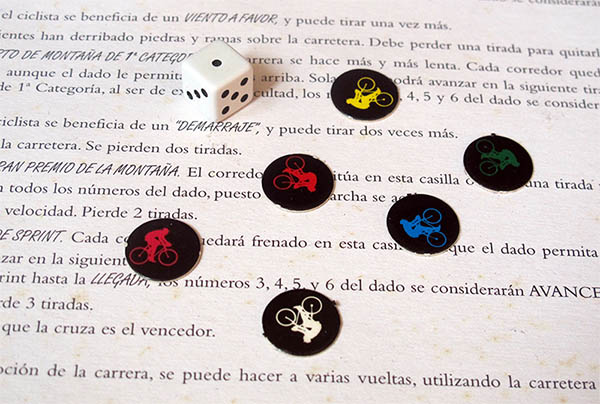
The rules, printed on the inner part of the lid, include three types of climbs, each of them harder than the previous one:
- On the 3rd category climb (red squares 21 to 33) riders only advance if they roll 1 ,2, 3, or 4, and stay where they are if they roll 5 or 6.
- On the 2nd category climb (orange squares 34 to 43) riders only advance if they roll 1,2, or 3, and stay where they are if they roll 4, 5, or 6.
- On the 1st category climb (yellow squares 44 to 50) riders only advance if they roll 1 or 2, and stay where they are if they roll 3, 4, 5, or 6.
To add insult to injury, square 48 is labelled "patches of ice." Falling on that square means missing two turns. Given that on that section you only advance with ones and twos, the chance of falling on that square is more than 50% (I will let you do the math).So, it is all uphill from square 21 to 50, hardly a landscape you will find in the Penedès. (And you will hardly find patches of ice either.)
To make things harder, the last final squares, though labelled "sprint," are uphill too, and they are not a 3rd category climb, as you might think since they are red squares, but, again, riders only move if they roll 1 or 2.
Note that on square 60 there is an alternative road leading back to square one, in case you want to play races of two or more laps. My guess is that not too many players ever even finished the first lap, probably quitting the game before. Though maybe after a few glasses of cava things are different.
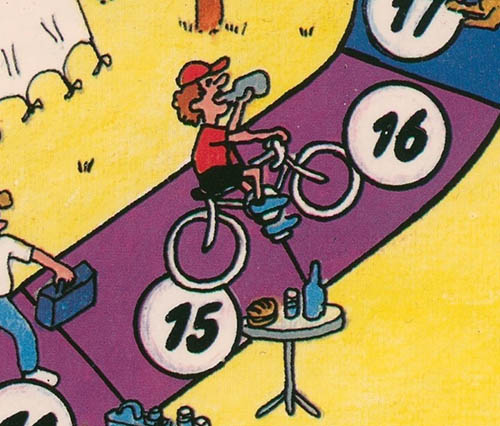
I hope he is not drinking cava!

...or maybe he was, after all!
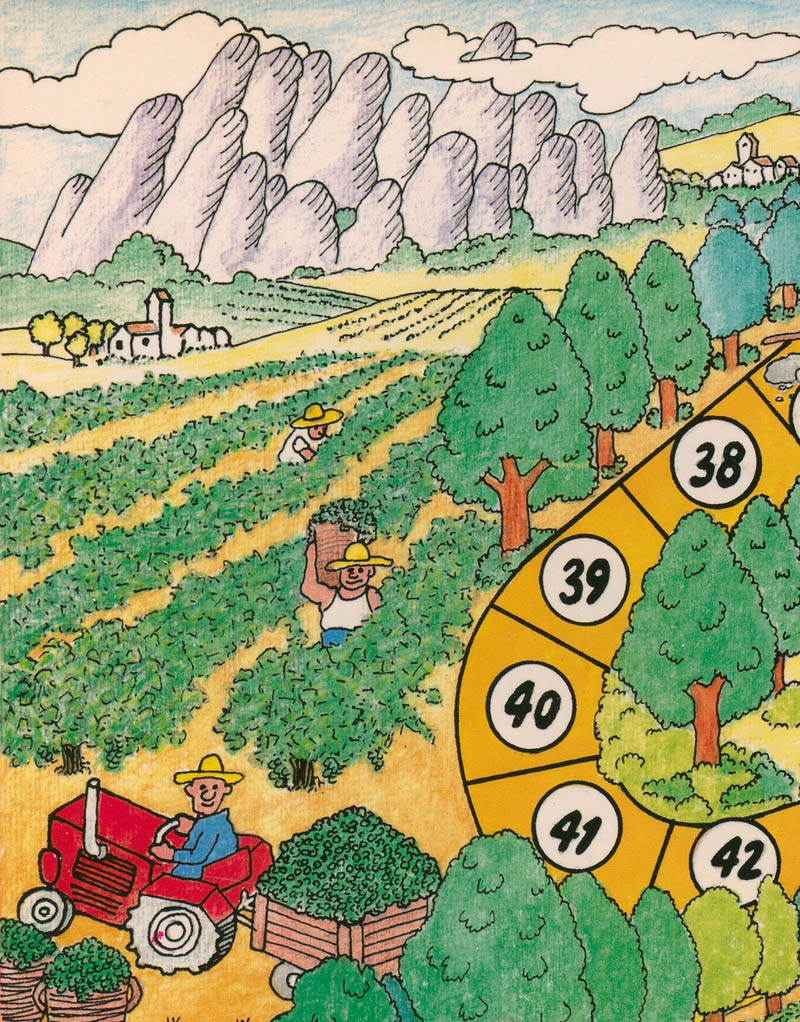
The mountain range dominating the landscape on the left upper side of the board is Montserrat, an impressive rock formation that can be seen from many kilometres away, the site of a well-known Benedictine abbey, and the focus of many legends and magic stories, among them one according to which the Holy Grail might be kept there. The mountain also has a long history of UFO sightings and even abductions dating back to the XIVth century.
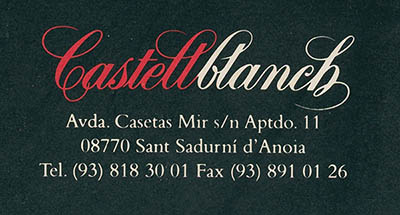
UPDATE June 2025: About the datation of this game:As I wrote when I first reviewed the game, "Sant Sadurní d'Anoia, home of the Castellblanch brand, hosted the cycling road races during the Barcelona 1992 Summer Olympics. Since there is no Olympic mention or reference in this game, I tended to think that the game had been issued before the 1992 Olympics. On the other hand, judging by the cars depicted and the cyclists' attire, the game might be from the eighties.
On the back of the box are Castellblanch's address and telephone/fax numbers. I have not researched when the fax arrived at Castellblanch's headquarters, but sometime in the eighties looks plausible. Furthermore, the address mixes Catalan and Spanish in a rather unusual way, hard to decode and even harder to explain in a few words to a non-Catalan (or non-Spanish). The name of the town is in Catalan, which is the official name of the town since little after the fall of the Spanish fascist regime in 1975 (forget the Spanish Wikipedia, which appears to be run by the regime's nostalgics, at least when it comes to names of Catalan towns). However, the street name is still in Spanish (it has changed its name to Catalan since then, but I have not been able to find the exact date). This mix of languages is consistent with the game being from the 1980s; it even looks like it could be from the early eighties, though it is hard to be conclusive about it."
Nevertheless, since Castellblanch sponsored a professional cycling team during the seasons 1994 and 1995, I have changed my first estimation of the game dating from the 1980s to the 1990s. The game is still hard to date with more precision. If you know better, please contact me.
Description written in May 2024.,
updated in June 2025.
 |
 |
 |
 |
 |
|
CULTURE IDEAS |
TOTUM REVOLUTUM THUMBNAILS |
NAMES ALPHABETICAL |
CATEGORIES LISTS |
WHAT'S NEW BLOG |